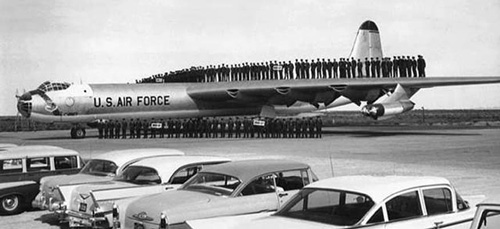
Believe-it-or-Not
In October 1957, Convair released a list of
believe-it-or-not facts about the B-36 bomber.
‣
The
wingspan of the B-36, 230 feet, is longer than the first
flight made by the Wright Brothers' Kitty Hawk Flyer in
1903.
‣
The B-36
can carry a heavier load of bombs for a greater distance
than any other airplane in existence. It has flown more
than 10,000 miles while carrying 10,000 pounds of bombs
halfway.
‣
At high
speeds, the B-36's ten engines deliver the equivalent of
more than 44,000 horsepower, roughly comparable to that of
nine locomotives, or about as much horsepower as that
generated by 400 average passenger cars.
‣
The
tremendous bomb load of the B-36 is clearly indicated by
the fact that a B-36 can haul up to 84,000 pounds of bombs
- more than a wartime B-24 bomber weighed when fully
loaded.
‣
The
volume of the B-36 bomb bays is 12,300 cubic feet,
approximately the capacity of three railroad freight cars.
‣
The
volume of the B-36 bomber, nearly 18,000 cubic feet,
approximates the volume of three average five-room houses.
‣
An
automobile could easily circle the globe 18 times with the
30,000-plus gallons of high-test gasoline in the wing tanks
of a B-36.
‣
More
than 27 miles of electrical wiring are required in the
Convair B-36 electrical system, equal to the amount needed
to wire 280 five-room houses.
‣
A
600-room hotel, or 120 five-room houses, could be heated by
the anti-icing equipment installed on the B-36 superbomber.
In an hour, the giant plane's anti-icing equipment turns
out 4,920,000 British thermal units.
‣
There
are 68,000 different shop-made parts and 11,000 different
assemblies per B-36 bomber, not counting the thousands upon
thousands of parts in government-furnished equipment.
‣
To
construct one 10,000-foot runway, plus a taxiway and small
apron, to support B-36 operations, takes 45 four-ton
trucks, moving 10 loads per day for 362 days, just to move
the required concrete. If the runway was outside the
continental U.S., it would take 20 victory ships or 12,000
C-54 cargo aircraft to haul the cement (not the sand or
gravel).
